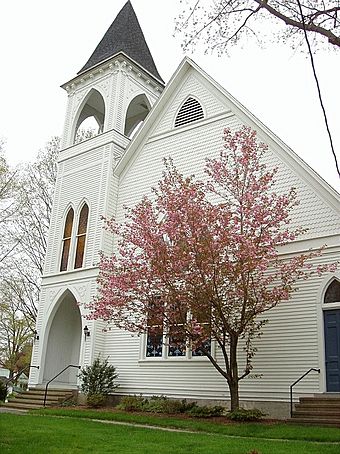Huntington Center Historic District facts for kids
Quick facts for kids |
|
|
Huntington Center Historic District
|
|

Huntington Congregational Church
|
|
| Location | Roughly along Church and Huntington Sts., from Ripton Rd. to the Farmill River, Shelton, Connecticut |
|---|---|
| Area | 60 acres (24 ha) |
| Architectural style | Colonial, Federal |
| NRHP reference No. | 00000296 |
| Added to NRHP | March 31, 2000 |
The Huntington Center Historic District is a special area in Shelton, Connecticut. It's like a living museum! This district protects many old and important buildings. These buildings show what the area was like when it was first settled.
This district was once the original colonial settlement of Shelton. It was first known as Huntington. The district stretches for about 1.2 kilometers (0.75 miles). It centers around the Huntington Green and its old cemetery. It also goes north along Church Street and south along Huntington Street. Most of the buildings here are homes. There are also two churches.
The Huntington Green was created in 1717. Many of the district's historic buildings were built over the next 150 years. The oldest house in the district was likely built around 1710. This historic district was added to the National Register of Historic Places in the year 2000.
English colonists first settled the area that is now Shelton in the 1600s. It was originally part of Stratford. In 1717, a church group called a Congregationalist parish was started. Later, in 1789, the town of Huntington was officially formed. This new town included what is now Monroe. The church area became the main center of the new town.
Besides being a town center, the area also had some small industries. These industries used power from the Farmill River and Means Brook. In the late 1800s, the town's focus shifted. New industries and town activities moved closer to the Housatonic River. This river forms the eastern border of the district. In 1919, the town was renamed Shelton. This was to honor Edward Shelton, a very important industrialist in the area. It is believed that Edward Shelton's family home still stands in Huntington Center today.
Important Places to See
This historic district has several important buildings and sites. They show the history and architecture of the area.
- Huntington Green, created in 1717. This open space has been a central part of the community for centuries.
- Josiah Wheeler House. This is one of the historic homes in the district.
- DeForest-Rudd House, built around 1770. This house is an example of Colonial style architecture.
- Huntington Congregational Church, built around 1890. This church features the Gothic Revival style.
- St. Paul's Episcopal Church, built in 1812. This church shows the Federal style of architecture.



